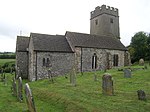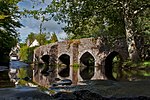Gupworthy railway station

Gupworthy (sometimes referred to as "Goosemoor") was originally intended as an intermediate station on the West Somerset Mineral Railway (WSMR), but neither the proposed extension to Heath Poult nor that to Joyce's Cleeve was built, leaving Gupworthy as the line's southwestern terminus. The WSMR was built primarily to carry iron ore from mines to Watchet harbour in Somerset, England. The line was unconnected to any other, though it passed under what is now the West Somerset Railway south of the village of Watchet. The station was located west of the top of the line's most striking feature - a three quarters of a mile, rope-hauled incline at a gradient of 1 in 4 (25%). From 1876 to 1883 a horse-drawn tramway brought iron ore from Kennesome Hill mine to the station, where it was transferred to WSMR wagons. The line's seven stations were designed by Rice Hopkins. Uniquely, no photograph of the station as built has been published, so whether it resembled all the others except Watchet is not known. It was built in anticipation of offering the usual goods and passenger facilities, but no regular passenger service ever ran south of Comberow. Before it was finished the building was converted into two dwellings and has now been remodelled.
Excerpt from the Wikipedia article Gupworthy railway station (License: CC BY-SA 3.0, Authors, Images).Gupworthy railway station
Stolford Hill,
Geographical coordinates (GPS) Address Nearby Places Show on map
Geographical coordinates (GPS)
| Latitude | Longitude |
|---|---|
| N 51.1099 ° | E -3.4832 ° |
Address
Stolford Hill
TA24 7BY , Exton
England, United Kingdom
Open on Google Maps








